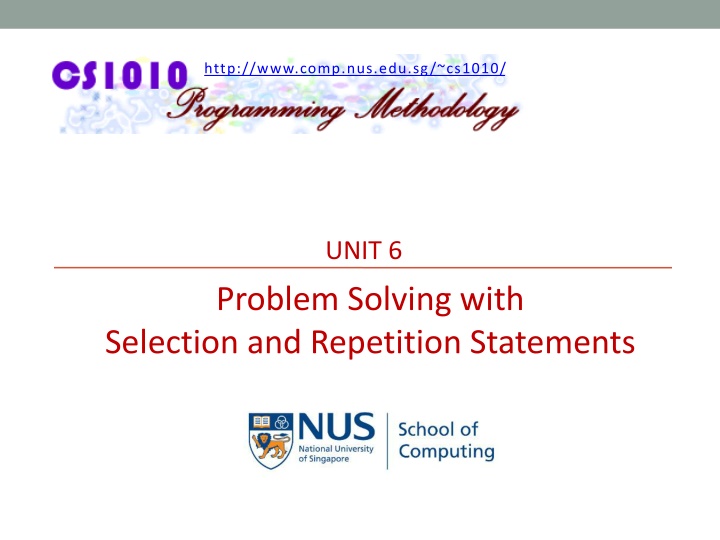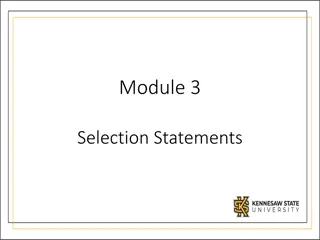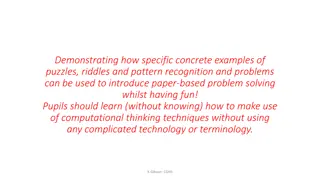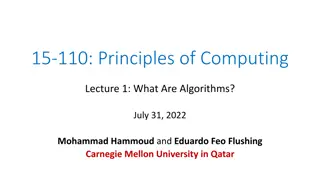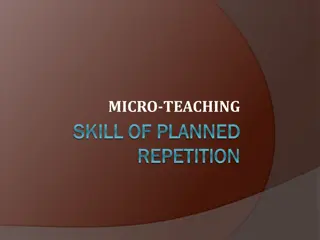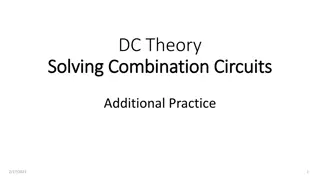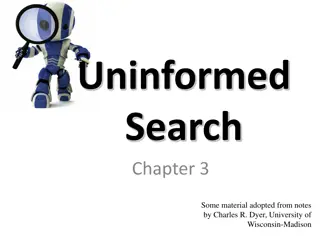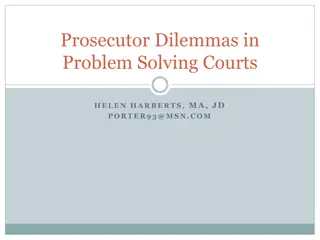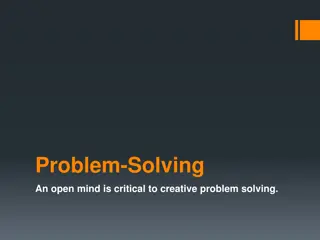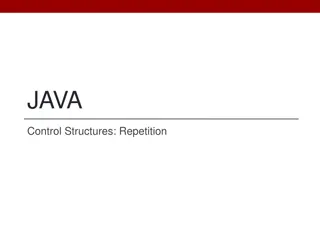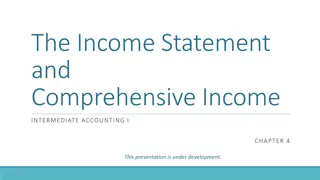Problem Solving with Selection and Repetition Statements
This content explores the concept of problem-solving using selection and repetition statements in programming. It covers topics such as sequential vs. non-sequential control flow, selection structures, nested if-else statements, loops (while, do-while, for), common errors, testing, debugging, and more. The material delves into using relational and logical operators, making decisions in code execution paths, and repeating code segments efficiently. It also provides insights on control structures for problem-solving scenarios.
Download Presentation

Please find below an Image/Link to download the presentation.
The content on the website is provided AS IS for your information and personal use only. It may not be sold, licensed, or shared on other websites without obtaining consent from the author.If you encounter any issues during the download, it is possible that the publisher has removed the file from their server.
You are allowed to download the files provided on this website for personal or commercial use, subject to the condition that they are used lawfully. All files are the property of their respective owners.
The content on the website is provided AS IS for your information and personal use only. It may not be sold, licensed, or shared on other websites without obtaining consent from the author.
E N D
Presentation Transcript
http://www.comp.nus.edu.sg/~cs1010/ UNIT 6 Problem Solving with Selection and Repetition Statements
Aaron Tan, NUS Unit 6: Problem Solving with Selection and Repetition Statements Problem Solving with Selection and Repetition Statements Unit6 - 2 Objectives: Using relational and logical operators Using selection statements to choose between two or more execution paths in a program Using repetition statements to repeat a segment of code Reference: Chapter 4 Selection Structures Chapter 5 Repetition and Loop Statements
Aaron Tan, NUS Problem Solving with Selection and Repetition Statements Unit6 - 3 Unit 6: Problem Solving with Selection and Repetition Statements (1/2) 1. Sequential vs Non-Sequential Control Flow 2. Selection Structures 3. Nested if and if-else Statements 4. Style Issues 5. Common Errors 6. The switch Statement 7. Testing and Debugging
Aaron Tan, NUS Problem Solving with Selection and Repetition Statements Unit6 - 4 Unit 6: Problem Solving with Selection and Repetition Statements (2/2) 8. The while Loop 9. The do-while Loop 10. The for Loop 11. Common Errors 12. Some Notes of Caution 13. Using break in Loop 14. Using continue in Loop
Aaron Tan, NUS Recall: Control Structures Problem Solving with Selection and Repetition Statements Unit6 - 5 Sequence Selection Repetition
Aaron Tan, NUS Problem Solving with Selection and Repetition Statements Unit6 - 6 1. Sequential Control Flow Recall Simple drawing problem in Unit 5: Write a program to draw a rocket ship, a male stick figure, and a female stick figure. rocket Draw Triangle Draw Rocket Ship Draw Rectangle male Draw Circle Draw Inverted V Draw 3 Figures Draw Male Stick Figure Draw Rectangle Draw Circle Draw Inverted V female Draw Triangle Draw Female Stick Figure Draw Inverted V
Aaron Tan, NUS Problem Solving with Selection and Repetition Statements Unit6 - 7 1. Non-Sequential Control Flow New requirement: Write a program to allow user to select only ONE of the following options: Draw a (1) rocket ship, (2) male stick figure, or (3) female stick figure. Draw Triangle Draw Rocket Ship Draw Rectangle Select only one Draw Circle Draw Inverted V Draw 3 Figures Draw Male Stick Figure Draw Rectangle Draw Circle Draw Inverted V Draw Triangle Draw Female Stick Figure Draw Inverted V
Aaron Tan, NUS Problem Solving with Selection and Repetition Statements Unit6 - 8 2. Selection Structures C provides two control structures that allow you to select a group of statements to be executed or skipped when certain conditions are met. if else switch
Aaron Tan, NUS Problem Solving with Selection and Repetition Statements Unit6 - 9 2.1 if and if-else Statements true cond? How are conditions specified and how are they evaluated? false if statement if(condition ) { /* Execute these statements if TRUE */ } Braces { } are optional only if there is one statement in the block. But for beginners, we recommended writing braces even if there is one statement. false true cond? if-elsestatement if (condition ) { /* Execute these statements if TRUE */ } else { /* Execute these statements if FALSE */ }
Aaron Tan, NUS Problem Solving with Selection and Repetition Statements Unit6 - 10 2.2 Condition A condition is an expression evaluated to true or false. It is composed of expressions combined with relational operators. Examples: (a <= 10), (count > max), (value != -9) Relational Operator < <= > >= == != Interpretation is less than is less than or equal to is greater than is greater than or equal to is equal to is not equal to
Aaron Tan, NUS Problem Solving with Selection and Repetition Statements Unit6 - 11 2.3 Truth Values Boolean values: true or false. There is no boolean type in ANSI C. Instead, we use integers: 0 to represent false Any other value to represent true (1 is used as the representative value for true in output) Example: Unit6_TruthValues.c int a = (2 > 3); int b = (3 > 2); printf("a = %d; b = %d\n", a, b); a = 0; b = 1
Aaron Tan, NUS Problem Solving with Selection and Repetition Statements Unit6 - 12 2.4 Logical Operators Complex condition: combining two or more boolean expressions. Examples: If temperature is greater than 40C or blood pressure is greater than 200, go to A&E immediately. If all the three subject scores (English, Maths and Science) are greater than 85 and mother tongue score is at least 80, recommend takinf Higher Mother Tongue. Logical operators are needed: && (and), || (or), ! (not). A B A && B False False False True A || B False True True True !A True True False False False False True True False True False True Note: There are bitwise operators such as & , | and ^, but we are not covering these in CS1010.
Aaron Tan, NUS Problem Solving with Selection and Repetition Statements Unit6 - 13 2.5 Evaluation of Boolean Expressions (1/2) The evaluation of a boolean expression is done according to the precedence and associativity of the operators. Operator Type Operator Associativity ( ) [ ] . -> expr++ expr-- Primary expression operators Unary operators Binary operators Left to Right * & + - ! ~ ++expr --expr (typecast) sizeof Right to Left Left to Right * / % + - < > <= >= == != && || ?: Ternary operator Assignment operators Right to Left Right to Left = += -= *= /= %=
Aaron Tan, NUS Problem Solving with Selection and Repetition Statements Unit6 - 14 2.5 Evaluation of Boolean Expressions (2/2) See Unit6_EvalBoolean.c What is the value of x? x is true (1) int x, y, z, a = 4, b = -2, c = 0; x = (a > b || b > c && a == b); gcc issues warning (why?) Always good to add parentheses for readability. y is false (0) y = ((a > b || b > c) && a == b); What is the value of z? z is true (1) z = ((a > b) && !(b > c));
Aaron Tan, NUS Problem Solving with Selection and Repetition Statements Unit6 - 15 2.6 Caution (1/2) Since the values 0 and 1 are the returned values for false and true respectively, we can have codes like these: int a = 12 + (5 >= 2); // 13 is assigned to a ( 5 >= 2) evaluates to 1; hence a = 12 + 1; int b = (4 > 5) < (3 > 2) * 6; // 1 assigned to b * has higher precedence than <. (3 > 2) evaluates to 1, hence (3 > 2) * 6 evaluates to 6. (4 > 5) evaluates to 0, hence 0 < 6 evaluates to 1. int c = ((4 > 5) < (3 > 2)) * 6; // 6 assigned to c (4 > 5) evaluates to 0, (3 > 2) evaluates to 1, hence (4 > 5) < (3 > 2) is equivalent to (0 < 1) which evaluates to 1. Hence 1 * 6 evaluates to 6. However, you are certainly not encouraged to write such convoluted codes!
Aaron Tan, NUS Problem Solving with Selection and Repetition Statements Unit6 - 16 2.6 Caution (2/2) Very common mistake: int num; What if user enters 7? Correct the error. printf("Enter an integer: "); scanf("%d", &num); if (num = 3) { printf("The value is 3.\n"); } printf("num = %d\n", num);
Aaron Tan, NUS Problem Solving with Selection and Repetition Statements Unit6 - 17 2.7 Short-Circuit Evaluation Does the following code give an error if variable a is zero? if ((a != 0) && (b/a > 3)) printf(. . .); Short-circuit evaluation expr1 || expr2: If expr1 is true, skip evaluating expr2 and return true immediately, as the result will always be true. expr1 && expr2: If expr1 is false, skip evaluating expr2 and return false immediately, as the result will always be false.
Aaron Tan, NUS Problem Solving with Selection and Repetition Statements Unit6 - 18 2.8 if and if-else Statements: Examples (1/2) if statement without else part int a, b, t; . . . if (a > b) { // Swap a with b t = a; a = b; b = t; } // After above, a is the smaller if-else statement int a; . . . if (a % 2 == 0) { printf("%d is even\n", a); } else { printf("%d is odd\n", a); }
Aaron Tan, NUS Problem Solving with Selection and Repetition Statements Unit6 - 19 2.8 if and if-else Statements: Examples (2/2) Move common statements out of the if-else construct. if (cond) { statement-a; statement-b; statement-j; statement-x; statement-y; } else { statement-a; statement-b; statement-k; statement-x; statement-y; } statement-a; statement-b; if (cond) { statement-j; } else { statement-k; } statement-x; statement-y;
Aaron Tan, NUS Problem Solving with Selection and Repetition Statements Unit6 - 20 3. Nested if and if-else Statements (1/2) Nested if (if-else) structures refer to the containment of an if (if-else) structure within another if (if-else) structure. For example: If it is a weekday, you will be in school from 8 am to 6 pm, do revision from 6 pm to 12 midnight, and sleep from 12 midnight to 8 am. If it is a weekend, then you will sleep from 12 midnight to 10 am and have fun from 10 am to 12 midnight.
Aaron Tan, NUS Problem Solving with Selection and Repetition Statements Unit6 - 21 3. Nested if and if-else Statements (2/2) Drawing task in Unit 5 int main(void) { draw_rocket(); printf("\n\n"); draw_male(); printf("\n\n"); draw_female(); printf("\n\n"); Draw only 1 figure int main(void) { char resp; printf("(R)ocket, "); printf("(M)ale, or "); printf("(F)emale? "); scanf("%c", &resp); if (resp == 'R') draw_rocket(); else if (resp == 'M') draw_male(); else if (resp == 'F') draw_female(); return 0; } return 0; }
Aaron Tan, NUS Problem Solving with Selection and Repetition Statements Unit6 - 22 4. Style Issues: Indentation (1/6) Once we write non-sequential control structures, we need to pay attention to indentation. Acceptable Non-acceptable if (cond) { statements; } else { statements; } if (cond) { statements; } else { statements; } if (cond) { statements; } else { statements; } No indentation! if (cond) { statements; } else { statements; } Closing braces not aligned with if/else keyword! if (cond) { statements; } else { statements; } Do you remember which vim command to auto-indent your program?
Aaron Tan, NUS Problem Solving with Selection and Repetition Statements Unit6 - 23 4. Style Issues: Indentation (2/6) Note that appropriate indentation of comments is just as important. Correct Incorrect // Comment on the whole if // construct should be aligned with // the if keyword if (cond) { // Comment on the statements in // this block should be aligned // with the statements below statements; } else { // Likewise, comment for this // block should be indented // like this statements; } // Compute the fare if (cond) { // For peak hours statements; } else { // For non-peak hours statements; }
Aaron Tan, NUS Problem Solving with Selection and Repetition Statements Unit6 - 24 4. Style Issues: Indentation (3/6) Sometimes we may have a deeply nested if-else-if construct: int marks; char grade; . . . if (marks >= 90) grade = 'A'; else if (marks >= 75) grade = 'B'; else if (marks >= 60) grade = 'C'; else if (marks >= 50) grade = 'D'; else grade = 'F'; This follows the indentation guideline, but in this case the code tends to be long and it skews too much to the right.
Aaron Tan, NUS Problem Solving with Selection and Repetition Statements Unit6 - 25 4. Style Issues: Indentation (4/6) Alternative (and preferred) indentation style for deeply nested if-else-ifconstruct: Alternative style int marks; char grade; . . . if (marks >= 90) grade = 'A'; else if (marks >= 75) grade = 'B'; else if (marks >= 60) grade = 'C'; else if (marks >= 50) grade = 'D'; else grade = 'F'; int marks; char grade; . . . if (marks >= 90) grade = 'A'; else if (marks >= 75) grade = 'B'; else if (marks >= 60) grade = 'C'; else if (marks >= 50) grade = 'D'; else grade = 'F';
Aaron Tan, NUS Problem Solving with Selection and Repetition Statements Unit6 - 26 4. Style Issues: Naming boolean variables (5/6) Here, boolean variables refer to int variables which are used to hold 1 or 0 to represent true or false respectively. These are also known as boolean flags. To improve readability, boolean flags should be given descriptive names just like any other variables. In general, add suffices such as is or has to names of boolean flags (instead of just calling them flag !) Example: isEven, isPrime, hasError, hasDuplicates int isEven, num; . . . if (num % 2 == 0) isEven = 1; else isEven = 0;
Aaron Tan, NUS Problem Solving with Selection and Repetition Statements Unit6 - 27 4. Style Issues: Removing if (6/6) The following code pattern is commonly encountered: int isEven, num; . . . if (num % 2 == 0) isEven = 1; else isEven = 0; In this case, the if statement can be rewritten into a single assignment statement, since (num % 2 == 0) evaluates to either 0 or 1. Such coding style is common and the code is shorter. int isEven, num; . . . isEven = (num % 2 == 0);
Aaron Tan, NUS Problem Solving with Selection and Repetition Statements Unit6 - 28 5. Common Errors (1/2) The code fragments below contain some very common errors. One is caught by the compiler but the other is not (which makes it very hard to detect). Spot the errors. Unit6_CommonErrors1.c int a = 3; if (a > 10); printf("a is larger than 10\n"); printf("Next line.\n"); Unit6_CommonErrors2.c int a = 3; if (a > 10); printf("a is larger than 10\n"); else printf("a is not larger than 10\n"); printf("Next line.\n");
Aaron Tan, NUS Problem Solving with Selection and Repetition Statements Unit6 - 29 5. Common Errors (2/2) Proper indentation is important. In the following code, the indentation does not convey the intended purpose of the code. Why? Which if is the else matched to? Unit6_CommonErrors3.c int a, b; . . . int a, b; . . . if (a > 10) if (b < 9) else if (a > 10) if (b < 9) else printf("Goodbye\n"); Same as printf("Hello\n"); printf("Hello\n"); printf("Goodbye\n"); int a, b; . . . Use braces if you want to make it more readable: if (a > 10) { if (b < 9) else } printf("Hello\n"); printf("Goodbye\n");
Aaron Tan, NUS Problem Solving with Selection and Repetition Statements Unit6 - 30 6. The switch Statement (1/3) An alternative to if-else-if is to use the switch statement. Restriction: Value must be of discrete type (eg: int, char) switch ( <variable or expression> ) { case value1: Code to execute if <variable or expr> == value1 break; case value2: Code to execute if <variable or expr> == value2 break; ... } default: Code to execute if <variable or expr> does not equal to the value of any of the cases above break;
Aaron Tan, NUS Problem Solving with Selection and Repetition Statements Unit6 - 31 6. The switch Statement (2/3) Write a program that reads in a 6-digit zip code and uses its first digit to print the associated geographic area. If zip code begins with 0, 2 or 3 4 6 7 8 or 9 others Print this message <zip code> is on the East Coast. <zip code> is in the Central Plains. <zip code> is in the South. <zip code> is in the West. <zip code> is invalid.
Aaron Tan, NUS Problem Solving with Selection and Repetition Statements Unit6 - 32 6. The switch Statement (3/3) #include <stdio.h> int main(void) { int zip; Unit6_ZipCode.c printf("Enter a 6-digit ZIP code: "); scanf("%d", &zip); switch (zip/100000) { case 0: case 2: case 3: printf("%06d is on the East Coast.\n", zip); break; case 4: case 5: case 6: printf("%d is in the Central Plains.\n", zip); break; case 7: printf("%d is in the South.\n", zip); break; case 8: case 9: printf("%d is in the West.\n", zip); break; default: printf("%d is invalid.\n", zip); } // end switch return 0; }
Aaron Tan, NUS Problem Solving with Selection and Repetition Statements Unit6 - 33 7. Testing and Debugging (1/3) Finding the maximum value among 3 variables: // Returns largest among num1, num2, num3 int getMax(int num1, int num2, int num3) { int max = 0; if ((num1 > num2) && (num1 > num3)) max = num1; if ((num2 > num1) && (num2 > num3)) max = num2; if ((num3 > num1) && (num3 > num2)) max = num3; return max; } Unit6_FindMax_v1.c What is wrong with the code? Did you test it with the correct test data? What test data would expose the flaw of the code? How do you correct the code? After correcting the code, would replacing the 3 if statements with a nested if-else statement work? If it works, which method is better?
Aaron Tan, NUS Problem Solving with Selection and Repetition Statements Unit6 - 34 7. Testing and Debugging (2/3) With selection structures (and next time, repetition structures), you are now open to many alternative ways of solving a problem. Alternative approach to finding maximum among 3 values: // Returns largest among num1, num2, num3 int getMax(int num1, int num2, int num3) { int max = 0; if (num1 > max) max = num1; else if (num2 > max) max = num2; else if (num3 > max) max = num3; return max; } Unit6_FindMax_v2.c What is wrong with this code? (There are more than one error.) What test data should you use to expose its flaw?
Aaron Tan, NUS Problem Solving with Selection and Repetition Statements Unit6 - 35 7. Testing and Debugging (3/3) The preceding examples will be discussed in class. Remember: Test your programs thoroughly with your own data. Do NOT rely on CodeCrunch to test your programs!
Aaron Tan, NUS 8. The while Loop Problem Solving with Selection and Repetition Statements Unit6 - 36 while ( condition ) { // loop body } false cond? true Loop body Braces { } are optional only if there is one statement in the block. But for beginners, we recommended writing braces even if there is one statement. If condition is true, execute loop body; otherwise, terminate loop. Each round of the loop is called an iteration.
Aaron Tan, NUS 8.1 The while Loop: Demo (1/3) Problem Solving with Selection and Repetition Statements Unit6 - 37 Keep prompting the user to input a non- negative integer, and print that integer. Enter a number: 12 Enter a number: 0 Enter a number: 26 Enter a number: 5 Enter a number: -1 The maximum number is 26 Halt the loop when the input is negative. Print the maximum integer input.
Aaron Tan, NUS 8.1 The while Loop: Demo (2/3) Problem Solving with Selection and Repetition Statements Unit6 - 38 maxi = 0; read num; maxi = 0; read num; while (num >= 0) { if (maxi < num) maxi = num; read num; } if (num >= 0) { if (maxi < num) maxi = num; read num; } else stop; if (num >= 0) { if (maxi < num) maxi = num; read num; } else stop; ... print maxi; print maxi;
Aaron Tan, NUS 8.1 The while Loop: Demo (3/3) Problem Solving with Selection and Repetition Statements Unit6 - 39 Unit6_FindMax.c #include <stdio.h> int main(void) { int num, maxi = 0; printf("Enter a number: "); scanf("%d", &num); while (num >= 0) { if (maxi < num) { maxi = num; } printf("Enter a number: "); scanf("%d", &num); } printf("The maximum number is %d\n", maxi); return 0; }
Aaron Tan, NUS 8.2 Condition for while Loop Problem Solving with Selection and Repetition Statements Unit6 - 40 // pseudo-code a = 2; b = 7; while (a == b) { print a; a = a + 2; } Output: ? When the loop condition is always false, the loop body is not executed. // pseudo-code a = 2; b = 7; while (a != b) { print a; a = a + 2; } Output: ? 2 4 6 8 10 : Press ctrl-c to interrupt When the loop condition is always true, the loop body is executed forever infinite loop.
Aaron Tan, NUS 8.3 Style: Indentation for while Loop Problem Solving with Selection and Repetition Statements Unit6 - 41 Loop body must be indented. Comment in loop body must be aligned with statements in loop body. Closing brace must be on a line by itself and aligned with the while keyword. while (cond) { // loop body statement-1; statement-2; ... } while (cond) { // loop body statement-1; statement-2; ... } or while (cond) { // loop body statement-1; ... } while (cond) { // loop body statement-1; statement-2; } No indentation!
Aaron Tan, NUS 9. The do-while Loop (1/3) Problem Solving with Selection and Repetition Statements Unit6 - 42 do { // loop body } while ( condition ); Execute loop body at least once. Loop body cond? true false
Aaron Tan, NUS 9. The do-while Loop (2/3) Problem Solving with Selection and Repetition Statements Unit6 - 43 do { // loop body } while ( condition ); Example: Count the number of digits in an integer. Unit6_CountDigits.c // Precond: n > 0 int count_digits(int n) { int count = 0; Assume that n is passed the value 395: n count 0 1 2 3 do { count++; n = n/10; } while (n > 0); 395 39 3 0 return count; }
Aaron Tan, NUS 9. The do-while Loop (3/3) Problem Solving with Selection and Repetition Statements Unit6 - 44 Style: similar to while loop or do { } while (cond); do { } while (cond); // loop body statement-1; statement-2; // loop body statement-1; statement-2; do { // loop body statement-1; statement-2; } while (cond); No indentation!
Aaron Tan, NUS 9. The do-while Loop: Exercise Problem Solving with Selection and Repetition Statements Unit6 - 45 It s time to practise Computational Thinking again! Add the digits in a positive integer. Eg: 395 17 Which concept in Computational Thinking is employed here? // Precond: n > 0 int count_digits(int n) { int count = 0; // Precond: n > 0 int add_digits(int n) { int sum = 0; do { count++; n = n/10; } while (n > 0); do { sum = sum + n%10; n = n/10; } while (n > 0); } return count; return sum; }
Aaron Tan, NUS 10. The for Loop (1/2) Problem Solving with Selection and Repetition Statements Unit6 - 46 for ( initialization; condition; update ) { // loop body } Initialization: initialize the loop variable Condition: repeat loop while the condition on loop variable is true Update: change value of loop variable
Aaron Tan, NUS 10. The for Loop (2/2) Problem Solving with Selection and Repetition Statements Unit6 - 47 Example: Print numbers 1 to 10 int n; for (n=1; n<=10; n++) { printf("%3d", n); } Steps: 1.n=1; 2.if (n<=10) { printf( ); n++; Go to step 2 } 3. Exit the loop
Aaron Tan, NUS 10.1 The for Loop: Odd Integers (1/3) Problem Solving with Selection and Repetition Statements Unit6 - 48 Unit6_OddIntegers_v1.c #include <stdio.h> void print_odd_integers(int); int main(void) { int num; printf("Enter a positive integer: "); scanf("%d", &num); print_odd_integers(num); return 0; } // Precond: n > 0 void print_odd_integers(int n) { int i; for (i=1; i<=n; i+=2) printf("%d ", i); printf("\n"); } print_odd_integers(12) 1 3 5 7 9 11
Aaron Tan, NUS 10.1 The for Loop: Odd Integers (2/3) Problem Solving with Selection and Repetition Statements Unit6 - 49 Unit6_OddIntegers_v2.c // Precond: n > 0 void print_odd_integers(int n) { int i; for (i=1; i<=n; i++) if (i%2 != 0) printf("%d ", i); printf("\n"); } // Precond: n > 0 void print_odd_integers(int n) { for ( ; n > 0; n--) if (n%2 != 0) printf("%d ", n); printf("\n"); } print_odd_integers(12) 1 3 5 7 9 11 Unit6_OddIntegers_v3.c Values printed from largest to smallest. Empty statement print_odd_integers(12) 11 9 7 5 3 1
Aaron Tan, NUS 10.1 The for Loop: Odd Integers (3/3) Which is better? Problem Solving with Selection and Repetition Statements Unit6 - 50 Unit6_OddIntegers_v1.c // Precond: n > 0 void print_odd_integers(int n) { int i; for (i=1; i<=n; i+=2) printf("%d ", i); printf("\n"); } Unit6_OddIntegers_v2.c // Precond: n > 0 void print_odd_integers(int n) { int i; for (i=1; i<=n; i++) if (i%2 != 0) printf("%d ", i); printf("\n"); }
